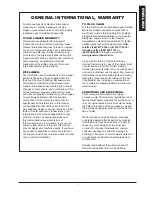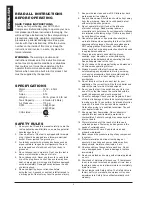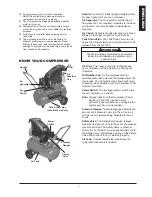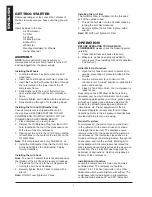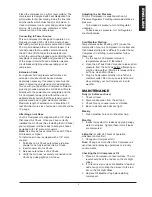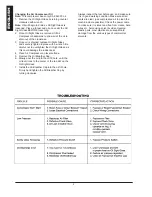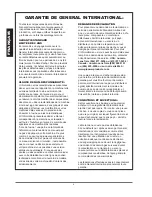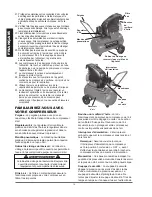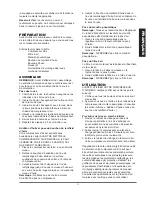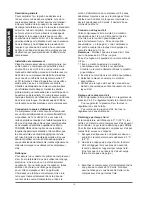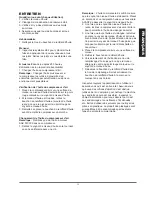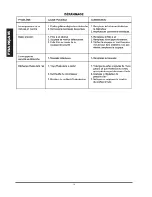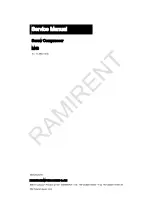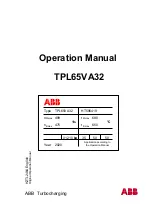
English
4
GettiNG StArted
Before operating your tool, check the contents of
the box to make sure you have everything you will
need.
Items included in the box:
Air Compressor
Air Filter
Air Chuck
Oil Breather Cap
Bottle of Oil
Wheels (2)
Mounting Hardware for Wheels
Owner’s Manual
ASSeMBLY
NOTE:
Before performing any assembly or
maintenance make sure compressor is turned off
and unplugged from the power supply.
Installing the Wheels
1. Locate the wheels, hex bolts, washers, and
wheel nuts.
2. Insert hex bolt through center hole in wheel rim.
3. Insert the hex bolt, with wheel in place, through
the hole located in the lower rear of the air
compressor frame.
4. Slide washer onto the end of bolt which you
have just pushed through the air compressor
frame.
5. Securely tighten bolt in place with the wheel nut.
6. Repeat steps 2 through 6 for remaining wheel.
Installing the Oil and Oil Breather Cap
Your air compressor is shipped without oil in
the crankcase. BEFORE STARTING THE AIR
COMPRESSOR YOU MUST ADD OIL TO THE
CRANKCASE AS DESCRIBED BELOW:
1. Place compressor on level ground.
2. Remove the Oil Shipping Plug from the Oil Fill
hole, located on the top of the crankcase cover
at the rear of the air compressor.
3. Slowly pour the oil into the Oil Fill hole, until the
oil level rises to the center of the red dot on the
Oil Sight Glass.
Note:
This compressor uses only SAE 5W-30 oil.
4. Install the Oil Breather Cap into the Oil Fill hole.
Firmly hand tighten the Oil Breather Cap by
turning clockwise.
Installing the Air Chuck
Note:
The use of a sealant tape is recommended on
the threads of the Air Chuck to prevent air leakage.
1. Thread the Air Chuck into the Air Regulator by
turning the Air Chuck clockwise.
2. Securely tighten the Air Chuck in place with a
wrench.
Note:
DO NOT over tighten Air Chuck.
Installing the Air Filter
The metal Air Filter is installed into the threaded
port of the cylinder head.
1. Thread the Air Filter into the Cylinder Head by
turning the Air Filter clockwise.
2. Securely tighten the Air Filter in place with a
wrench.
Note:
DO NOT over tighten Air Filter.
OPerAtiON
BEFORE OPERATING YOUR NEW AIR
COMPRESSOR
please check the following points
carefully:
1 Check that all nuts and bolts are secure.
2. Make sure oil has been properly added to
compressor. (See Installing Oil and Oil Breather
Cap section.)
Initial Start-Up Procedure
1. Open the Air Tank Drain Valve to permit air to
escape, preventing air pressure buildup in the
air tank.
2. Run the compressor for a minimum of 20
minutes in this “no-load” position to lubricate the
piston and bearings.
3. Close Air Tank Drain Valve. Your compressor is
ready for use.
Depending on the CFM draw of the tools being
operated, your new Air Compressor can be used
for operating paint sprayers, air tools, grease guns,
airbrushes, caulking guns, abrasive blasters, tire
& plastic toy inflation, spraying weed killer and
insecticides, etc. Proper adjustment of the Air
Pressure Regulator is necessary for all of these
operations. Refer to the air pressure specifications
provided with the tool you are using.
General Overview
To compress air, the piston moves up and down
in the cylinder. On the down stroke air is drawn
in through the valve inlet. The discharge valve
remains closed. On the upstroke of the piston air
is compressed. The inlet valve closes and air is
forced out through the discharge valve, through the
check valve, and into the air tank. Working air is
not available until the compressor has raised the
tank pressure above that required at the air service
connection. The air inlet filter openings must be
kept clear of obstructions, which could reduce air
delivery of the compressor.
Installation and Location
Locate the compressor in a clean, dry and well
ventilated area. The compressor should be
located 12 to 18 inches from walls or any other
obstruction which would interfere with airflow. The
compressor should be located in a temperature
controlled area between 32° and 95° fahrenheit.



